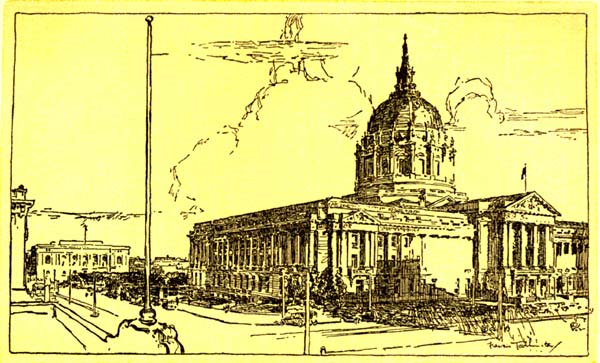| Home -> Other California Books -> Fascinating San Francisco -> Hills and Vista | |||
|
Hills and Vistas
What city built on hills has not been exalted in song and legend? San Francisco, like Athens, Jerusalem, Rome and Naples, has the spell that comes from setting one's house on a high place. Those who can look out over the world are those who dominate it. History shows that every three hundred years a great city arises at some very necessary and strategic point on the international highway. Such an inevitable world city is San Francisco. Whether it is the ragged slope of Telegraph Hill, the heights of Twin Peaks, the rolling green-brown softness of the Potrero bluffs, or the contours of any of the other high places that confront the visitor approaching from the Bay, the hills of San Francisco arrest the eye and intrigue the imagination. To the visitor who would comprehend almost at a glance the cycloramic setting of San Francisco the way is easy of access to half a dozen peaks. There are good automobile roads to all of them. Let him for a start go to Nob Hill, crossed by California street, where the Fairmont Hotel, the Pacific Union Club, Grace Cathedral and many distinctive residences and apartments will engage his attention when it is not occupied with the shipping in the harbor, Goat and Alcatraz islands, and the animated perspectives inside the Golden Gate. Russian Hill, of which Nob Hill is a southward shoulder, is the habitat of many of the writer and painter folk of San Francisco. It affords superb panoramas of the city and bay. So does Telegraph Hill, whose sides have been scarred to provide rock for the sea wall along which the modern argosies of commerce discharge their cargoes. Views northwesterly from these hilltops suggest the Bay of Naples. The most comprehensive close-up of the city is probably obtained from the crest of Buena Vista Park, which is not the highest of the fourteen good-sized hills in San Francisco but the one from which the most unobstructed views are to be obtained. Tourists and other visitors to San Francisco who enjoy walking will find, rambling over this height most interesting. Street cars, Nos. 6 or 7, will take you to Haight and Broderick streets, from which point many paths lead to the top of the hill. At every turn there is an effective view. Through a tunnel-like alley of shrubbery the towers of St. Ignatius, with crosses pointing to the sky, loom like spires from one of the cathedral towns of France. As you swing 'round you obtain glimpses from different angles of the skyscrapers of San Francisco, with every now and then a stretch of glistening water. From the summit of Buena Vista you see, on three sides, expanses of ocean and bay. To the left is the diamond of Lake Merced in its setting of bluegreen eucalyptus and its surrounding waves of sand, ribboned with roads extending to the ocean beach. Beyond is the emerald stretch of Golden Gate Park, with buildings in demi-outline through the changing tones of foliage. Above and beyond are the rolling hills of the Presidio, and in the distance Tamalpais rears its friendly bulk, a dark blue shadow against a cerulean mantle, crowned at times with filmy gonfalons of cloud like a color print by Hokusai. Lone Mountain and its cross, visible far out at sea, is here in conspicuous range. To see San Francisco in a series of highly colored pictures suggestive of Maxfield Parrish or Dulac go to the scenic boulevard that winds over Twin Peaks. You may motor there, walk or take a street car to the foot of this city mountain, the ascent either way being easy. You may scale Twin Peaks from the flank within view of Market street, climbing along the side and over the shoulder by way of the boulevard. Or if you prefer, you may climb up from Sloat Boulevard via Portola Drive throughone of the city's restricted residence sections. On the summit of Twin Peaks you feel at the top of the world, and you see San Francisco spread out below you as multicolored as a rug of Kermanshah. No other city in the two Americas, not excepting Quebec or Rio de Janeiro, so overwhelms the beholder with its vistas - with its luminous enchantments. At night the lights of the city zigzag in patterns of distracting loveliness, and Market street reaches from the foot of the mountain to the Embarcaderolike the tail of some flaming comet athwart a sea of stars. |
|||
 |
|||
|
Civic Center
The City Hall, and at the left, beyond the formal garden, the Library |
|||